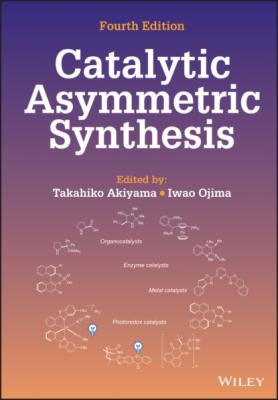Catalytic Asymmetric Synthesis. Группа авторов
Чтение книги онлайн.
Читать онлайн книгу Catalytic Asymmetric Synthesis - Группа авторов страница 47
 alt="Schematic illustration of [3+2] Cycloaddition reaction of isatin-derived 3-indolylmethanols."/>
alt="Schematic illustration of [3+2] Cycloaddition reaction of isatin-derived 3-indolylmethanols."/>
Scheme 2.49. [3+2] Cycloaddition reaction of isatin‐derived 3‐indolylmethanols.
Source: Based on [101].
Scheme 2.50. Generation of the indolenium ion intermediate.
Source: [102, 103].
Scheme 2.51. [4+3] Cycloaddition reaction of indolyl alcohol.
Source: Based on [104].
Scheme 2.52. [3+2] Cycloaddition of 2‐indolylmethanols.
Source: Bera and Schneider [105].
Shi reported a [3+3] cycloaddition reaction between 2‐indolylmethanols and azomethine ylides to afford a tetrahydro γ‐carboline framework using CPA 12b (Scheme 2.53) [107]. Presence of diaryl moieties (Ar1) at the 2′‐position is critical for the cycloaddition reaction to proceed. Transition state model is proposed.
Scheme 2.53. [3+3] Cycloaddition of 2‐indolylmethanols.
Source: Based on [107].
Schneider reported a [4+3] cycloannulation reaction between ortho‐quinone methides and carbonyl ylides to furnish functionalized oxa‐bridged dibenzooxacines in 56–95% yields and with 82–94% ee in a single synthetic step catalyzed by CPA 6r (Scheme 2.54). The combination of rhodium complex and CPA 6r worked cooperatively [108]. Chiral phosphoric acid formed hydrogen‐bonded o‐quinodimethane intermediate starting from o‐hydroxybenzylalcohol. Carbonyl ylide was generated by Rh‐catalyzed decomposition of α‐diazoester tethered to an aryl ketone.
Vicario reported [4+3] cycloaddition reaction between furans and oxa‐allyl cations, which were generated in situ from allenamides and DMSO as an oxidant, catalyzed by CPA 14d (Scheme 2.55) [109]. Authors proposed that both hydrogen bond and electrostatic interactions through ion pairing with the oxalyl cation dienophile were involved.
2.4.5. Nazarov Cyclizations
The Nazarov 4π‐conrotatory electrocyclization reaction is a useful and powerful method for the construction of cyclopentanones. Rueping reported the first Nazarov cyclization reaction catalyzed by phosphoramide 14 in 2007 [110]. Tius reported a Nazaro cyclization that generated a vicinal all‐carbon quaternary stereocenter using chiral phosphoramide 14 as the catalyst [111]. Enantioselective Nazarov reactions were limited to activated substrates or cyclic ketones. List reported a Nazarov reaction of simple, acyclic, aliphatic‐substituted divinyl ketones using confined IDPi 11l to furnish 2‐methylene cyclopentenone with 92–99% ee (Scheme 2.56) [112].
Scheme 2.54. [4+3] Cycloannulation reaction between ortho‐quinone methides and carbonyl ylides.
Scheme 2.55. [4+3] Cycloaddition reaction between furans and oxa‐allyl cations.
Source: Based on [109].
Chan reported a dehydrative Nazarov‐type electrocyclization reaction of electron‐rich aryl‐ and 2‐thienyl‐β‐amino‐2‐en‐1‐ols using 14e. The 4π conrotatory electrocyclization gave a wide variety of 1H‐indenes and 4H‐cyclopenta[b]‐thiophenes (Scheme 2.57) [113].
Tu reported a tandem Nazarov cyclization semipinacol rearrangement reaction using unactivated substrates to furnish spiro[4.4]nonane‐1,6‐diones using chiral phosphoramide 14f (Scheme 2.58) [114].
Scheme 2.56. Nazarov reaction of acyclic divinyl ketones.
Source: Based on [112].
Scheme 2.57. Nazarov‐type electrocyclization.
Source: Based on [113].
Scheme 2.58. Tandem Nazarov cyclization semipinacol rearrangement reaction.
Source: Based on [114].
2.5. MICHAEL REACTIONS
Enamine catalysis may be employed to construct a carbon–carbon bond at the α‐substituted position of a ketone using the Michael reaction. However, a stoichiometric amount of enantiopure amine is required for the asymmetric synthesis. List proposed an “enol catalysis,” in which CPA 6e accelerated both enolization and activation of the electrophile and the nucleophile through their Brønsted acidic P–OH and Brønsted basic P=O moieties to furnish α,α‐disubstituted cyclohexanone derivatives with 81–96% ee (Schemes